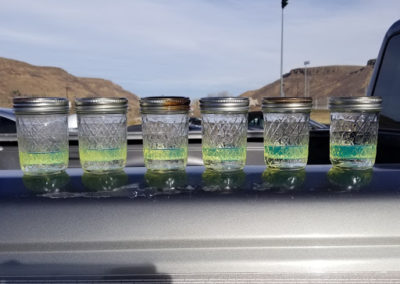18.5 Newmont Diesel Modification
Overview
Since the beginning of the senior design capstone project, the team has been working diligently with Newmont Corporation. Newmont’s primary goal for the team has been to reduce the amount of emissions and increase fuel efficiency in diesel mining equipment. There are a number of benefits of doing this. The benefits range from receiving tax credits to reducing the negative impacts that diesel emissions have on the environment. In the first semester, the team worked with Newmont in order to understand the impacts of running biodiesel at different blends in a heavy industry biodiesel engine. Specifically, the team looked at the engines that power Caterpillar 250 ton haul trucks. After communicating with Newmont, as well as Caterpillar, to understand the effects of running different blends of biodiesel in large Caterpillar engines, the team came up with a suggestion for Newmont to be able to compare three different blends of Biodiesel (B20, B50 and B100) on a mining site located in Suriname. While the client was satisfied with the progress that the team had made up to the end of the first semester, Newmont and the team decided to change directions and focus more on the underground mining services as opposed to the above-ground services.
At the beginning of this semester, the team once again conversed with Newmont in order to understand the clients’ needs for these underground mines. The main goal for Newmont is to decrease the amount of diesel emissions underground. As a result, the ventilation energy requirements can be reduced and Newmont will be able to save a significant amount of money as ventilation is one of their main costs. In order to achieve this decrease in emissions, Newmont and the team believes that the best and most efficient way to do this would be to implement an additive into the diesel fuel. A diesel additive would be able to reduce the amount of emissions, and therefore, the amount of ventilation energy needed for underground mines. Therefore, the team has looked into eight different additives. After quick review, this became five as three were not EPA certified.
The end goal of this project is to determine the additive that will reduce the emissions the most, while ideally increasing fuel efficiency and maintaining similar power levels. The primary focus of this semester was to run bench scale tests on the five EPA certified additives in order to get valuable comparison data. This will aid in determining which additives will later be run on a dynamometer test in order to get more applicable results. The bench scale tests laid out below in the scope of work were researched and decided on unanimously by both the team as well as the client. The chosen bench scale tests would satisfy the clients’ needs to determine which of the additives should be considered for the dyno testing.
The team has come up with a cost associated with the bench scale testing as well as a schedule for this portion of the project. While the bench scale testing was the main focus for the semester, the team has also put together a schedule and a scope of work for the dyno testing and what the team believes these tests will look like after the bench scale tests are completed and analyzed.
Live Zoom Chat
Use the link below to join us live from 8:00 – 10:30 a.m. on December 3.
Please use passcode: diesel
Meeting ID: 775 7311 3037
Team Members
- Brady Robinson
- Jacob Barson
- Josh Gregory
- Nicholas Gertie
The Client
- Newmont
Acknowledgements
Project Advisor: Robin Bullock
Technical Advisor: Virtual Energy
Special Thanks To:
Mike Aire
Ron Miller
Video
Elevator Pitch
Take a moment to think about mining. What are the first things that come to mind? Maybe the tools that miners use, or the big trucks that haul the minerals. To some the process might be fascinating. To others, it could be dangerous. Some of these thoughts might be more positive than others, but as engineers, our main focus is to create solutions and make processes better. Mining is an extremely important profession, but there are a number of drawbacks that come with the industry, particularly the danger and the emissions. Newmont, the largest gold mining corporation in the world, is constantly looking for solutions to the industry’s problems.
Now of course, there are a number of potential solutions to many of the problems. Newmont came to the team with the whole goal of decreasing emissions first and foremost. After working with Newmont about their desires and needs, the team came up with a variety of solutions. The first semester was really focused on using biodiesel in heavy industry diesel engines like in haul trucks in order to create a carbon neutral solution to the large emissions that these big trucks produce. This would help with a large number of problems talked about above like haul trucks and pollution.
After further project development, the team also wanted to explore diesel fuel additives for underground mining. This is what the second semester focused on. What these additives could do for the underground mining industry could potentially have an even larger impact than biodiesel on many of the mining industry issues like reducing emissions as well as making the underground environment safer and cleaner for the miners. This plan with the additives could be implemented much quicker as well, and therefore will be the main focus moving forward.
While working with Newmont, completing engineering analyses and running tests, the team worked to pick a select few additives that will continue to be researched and tested over the following couple of semesters in order to pick the right additive for Newmont’s specific purpose. Testing will be carried on with a new group of students in the following semesters and the team is excited to keep up with the project and what will come out of it. Please watch our elevator pitch video in order to get another grasp of our project. Thank you!
Design Approach
There were three different types of biodiesel concepts that were developed over the first semester. There was an economic analysis done with three blends of B20, B50, B100. These were specified by the client, and are a current blend percentage when looking at what many companies are using in either industry or research. The economic analysis of the three types of blends was where the majority of the time was spent during the first semester, and figure 1 below shows the general concept that the team was moving towards for the end of the semester.
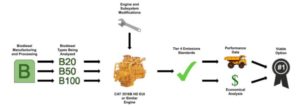
In order to decide upon the best viable biodiesel mixture option for Newmont, it was important to first analyze the manufacturing and processing methods of the fuel. Then, the team determined what engine and related subsystem modifications would be necessary for the reliable operation of biodiesel in a CAT 3516B HD EUI or similar haul truck engine. It would also be necessary for the haul trucks to still meet Tier 4 emissions standards, so emission data was analyzed. A combination of an economical analysis and performance data in an actual engine would determine the top option for Newmont to utilize. While the engine and subsystem modifications, the performance data, and the economics of the different blends will all vary, figure 1 shows a concise way to represent the initial goal for the majority of the first semester.
After analyzing the three main biodiesel mixtures, an on-site fuel pump station was designed, planned, and priced. Without a pump station, Newmont would be out of the mixing process, and would be paying extra for the pre-mixed blends to be delivered on-site. The chosen biodiesel mixing method, and what had been requested by Newmont, was metered pump mixing on site. The team determined the density sampling rate to ensure the biodiesel blends would be a homogeneous mixture, determined the dimensions of all necessary tanks, selected all components of the pump station, created a detailed drawing of the station, as seen in figure 2, and created a price breakdown for the entire station.
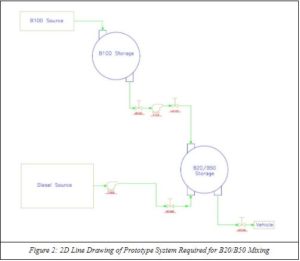
At the beginning of the second semester, the team once again conversed with Newmont in order to understand the clients’ needs. The main goal for Newmont was to decrease the amount of diesel emissions in underground mines. As a result, the ventilation energy requirements can be reduced, miners will have safer working environments, and costs will be cut. In order to achieve this decrease in emissions, Newmont and the team believed one of the best and most efficient ways to do this would be to implement an additive into the diesel fuel. A diesel additive would be able to reduce the amount of emissions, and therefore, the amount of ventilation energy needed for underground mines. Therefore, the team looked into testing and comparing five diesel additives, to ultimately determine the additive that will reduce the emissions the most, while ideally increasing fuel efficiency and maintaining similar power levels.
In order to compare the five diesel additives, four bench-scale fuel tests were determined useful by the team. These consisted of a cetane number test, kinematic viscosity test, water and sediment test, and visual burn test. The visual burn test and water and sediment test were conducted by the team on campus. The cetane number test and kinematic viscosity test were outsourced to a third-party laboratory due to the equipment requirements for the tests. By comparing the bench-scale fuel test results, the team could determine which additive would theoretically be the best at decreasing emissions and which additive would ultimately be the most cost effective. By narrowing down the additives with bench-scale testing, the best path could be selected for Newmont in terms of physical engine testing, which will be conducted in the following semester.
Design Solution
Our first semester was focused on biodiesel implementation on Newmont’s mine sites. The emissions benefits of biodiesel are fairly straight forward. B20, B50 and B100 are 20% 30% and 100% carbon neutral respectively. It’s in necessary infrastructure, engine performance and engine maintenance that there are unknowns. In order to validate the possibility of implementing biodiesel on site, Newmont was interested in performing a cost analysis regarding the use of biodiesel on site. This included tracking down the necessary equipment for storage, mixing and delivery of these fuel blends on site. We also conducted a cost analysis regarding potential changes to engine maintenance as well as longevity. This data allowed us to provide Newmont with an expected financial cost for biodiesel implementation. Newmont could then make a more informed decision regarding implementation of biodiesel on site and perform a cost benefit analysis before moving forward. Our collected and calculated data is shown below.
Table X, below, Shows a cost comparison between the selected fuel mixtures. As you can see as biodiesel content in the mixture increases, so does cost.
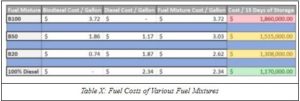
Table Y below, shows the costs of necessary infrastructure and equipment. This includes tanks for storage, pumps for moving and mixing fuel, metering devices and more.
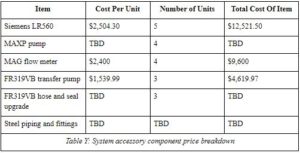
Our infrastructure and costs analysis data will serve as an excellent starting point for future decisions regarding biodiesel implementation on site.
Our second semester was focused on the potential benefits of diesel fuel additives on site.
These additives boast a number of positive attributes when properly mixed with diesel fuels including: cetane management, improved general emissions, and improved engine performance. In order to verify these claims, we will be conducting a series of bench scale tests directly addressing these claims. Our selected tests and the properties they are focused on are shown below:
Cetane Number Test Summary (ASTM D613)
The Cetane Number Test (ASTM D613) determines the rating of cetane number using a standard single cylinder, four-stroke cycle, variable compression ratio, indirect injection diesel engine. This test covers the cetane number scale from 0 to 100, while tests typically range from 30 to 65.
Pros:
- Accurate
- May be used for unconventional fuels
- Allows for a numerical comparison of the diesel additives
Cons:
- Cetane test engine required
- Testing must be outsourced to a third party as a result
Water and Sediment Test Summary (ASTM D4176)
The Water and Sediment Test (ASTM D4176) involves two different procedures that estimate the presence of free water and solid particulate contamination suspended in distillate fuels. Both tests can be used as field tests at storage temperatures or laboratory tests at a controlled temperature. The first procedure will give a rapid pass/fail result for contaminated fuel, while the second procedure will give a numerical result of the haze appearance.
Pros:
- Can be conducted on campus
- Inexpensive
- Good visual guide
Cons:
- No numerical comparison
Kinematic Viscosity Test Summary (ASTM D445)
The Kinematic Viscosity Test (ASTM D445) measures the time for liquid petroleum products to flow under gravity through a glass capillary viscometer. Dynamic viscosity can be calculated by multiplying the kinematic viscosity by the density of the fuel.
Pros:
- Can be conducted on campus
- Inexpensive
- Relates to level of fuel combustion
- Relates to mechanical wear on equipment
Sulfur Test Summary (ASTM D7039)
The Sulfur Test (ASTM D7039) precisely measures the total sulfur content of the diesel fuel using monochromatic wavelength-dispersive X-ray fluorescence spectrometry. Sulfur content of fuel is important to know for the blending of products and process control.
Pros:
- Typical five-minute analysis time
- Provides numerical comparison
Cons:
- Testing must be outsourced to a third party
Visual Burn Test Summary
A burn test offers a quick way to visualize and compare the color of the flame of each fuel mixture, along with a rapid way to compare the rate at which the additized fuel mixtures burn. For example, diesel mixtures with a higher cetane number should completely burn faster than those with lower cetane numbers, assuming the same volume of fuel is burned. This test also offers a way to visually determine which mixtures burn with higher levels of soot. At the end of each burn test, it can also be determined, visually, which mixtures leave higher levels of residue and soot .
Pros:
- Can be conducted on campus
- Rapid, visual results
- Inexpensive
Cons:
- No numerical data
- Not under engine-operation conditions
We were able to conduct the Burn Test and the Water and Sediment tests on campus. The remaining three tests were outsourced to a private lab. The main driver in this decision to outsource was based upon the required tools and equipment to conduct these tests. With our selected test, we will be available to provide Newmont with valuable data regarding the performance of these additives in a controlled environment. This allows us to verify which additives meet the criteria Nemont is most interested in at the lowest possible cost. Conducting bench scale tests requires no investment in infrastructure, and provides no opportunity for issues to occur on site.
The collected data will allow Newmont to select the additives that best meet their needs. Thus allowing them to proceed with future dyno experiments and on site testing with just a few selected additives. Lowering the overall cost of the next phase of experiments drastically.
Next Steps
For this particular project, the next steps are vital in order for Newmont to pick the correct additive. This semester, the team did a large amount of work determining which five additives should be potential candidates for Newmont to use in their underground mining equipment. The team did even more testing in a lab environment in order to further narrow the playing field. From here, the select few of the five additives will now need to be run in an engine on a dyno in order to further measure the emissions and the power effects that each additive has on the engines that Newmont uses in the field. After doing the lab testing on a dyno, once again, the top couple additives will then be slowly implemented into some of Newmont’s mines and field testing will then occur to determine the best additive option for Newmont. This project cannot be rushed in order for Newmont to determine the best possible additive in order to make the air cleaner and the workers’ lives better.
Meet the Team
Brady Robinson

My name is Brady Robinson. I am a mechanical engineer and will be graduating in December of 2020. I am currently in Professor Gregory Bogin’s Internal Combustion engines class, and have completed his vehicle dynamics and powertrain systems class. I have substantial amount of automotive and engine modification/building experience. I have worked on multiple compression and spark ignition engines. I have a passion for improving the power and efficiency of specifically compression ignition engines as well as reducing the emissions produced.
Jacob Barson
 I’m Jacob Barson. I’m a mechanical engineering student at the Colorado School of Mines graduating in December of 2020. Throughout my time here at Mines I have been involved in a variety of projects ranging from autonomous parking meters to plastic extruders. These projects have provided numerous opportunities for personal development regarding communication, team leadership, engineering skills and more. Outside of academics, I have participated in several internship programs. I have been working with the Advanced Fuels and Combustion group at NREL for the last 19 months. I have designed, fabricated and implemented two separate bench scale systems for research data collection regarding flow rates of various fuels during piezo-electric diesel injector operation.
I’m Jacob Barson. I’m a mechanical engineering student at the Colorado School of Mines graduating in December of 2020. Throughout my time here at Mines I have been involved in a variety of projects ranging from autonomous parking meters to plastic extruders. These projects have provided numerous opportunities for personal development regarding communication, team leadership, engineering skills and more. Outside of academics, I have participated in several internship programs. I have been working with the Advanced Fuels and Combustion group at NREL for the last 19 months. I have designed, fabricated and implemented two separate bench scale systems for research data collection regarding flow rates of various fuels during piezo-electric diesel injector operation.
Josh Gregory

My name is Josh Gregory. I am a mechanical engineering student and will be graduating with an area of emphasis in automotive engineering in December, 2020. I am currently taking an internal combustion engine course with Dr. Bogin from NREL, and have previously taken vehicle dynamics, as well as three semesters of automotive design. For the past two years, I have been a member of the Mines Formula SAE team, working on the brakes subsystem for our car. Outside of school, I work part time at Adjust-A-Grate as a machinist, manufacturing components for aluminum window well covers, using a few different CNC machines. Along with classes and work, I am a sprinter and javelin thrower on the Mines varsity track team
Nicholas Gertie

Hi. My name is Nicholas Gertie and I am interested in this project because of my interest in engines. I have done undergraduate research with hydrogen compression. I have interned at a drilling company named Helmerich and Payne last summer and will be working for Cimarex energy as an oil production engineer.



